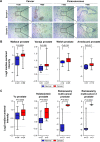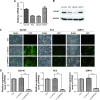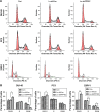PPP5C promotes cell proliferation and survival in human prostate cancer by regulating of the JNK and ERK1/2 phosphorylation
- PMID: 30254472
- PMCID: PMC6140725
- DOI: 10.2147/OTT.S161280
PPP5C promotes cell proliferation and survival in human prostate cancer by regulating of the JNK and ERK1/2 phosphorylation
Abstract
Background: Prostate cancer (PCa) is one of the most common malignancies and a major leading cause of cancer-related deaths in males. And it is necessary to explore new molecular targets to enhance diagnosis and treatment level of the PCa. Serine/threonine protein phosphatase 5 (PPP5C) is a vital molecule that Involve in complex cell physiological activity.
Purpose: The objective of this study was to detecte the expression level of PPP5C in the tissue of prostate cancer patients and further discussed the PPP5C biological function and mechanisms on the PCa.
Methods: The expression level of PPP5C was analyzed by immunohistochemistry and ONCOM-INE datasets. Lentivirus-mediated short hairpin RNA (shRNA) was constructed to silence the expression of PPP5C in prostate cancer cell. Cell viability and proliferation were measured using MTT and colony formation, and the cell cycle and apoptosis was analyszed by flow cytometry. The changes of downstream protein level and protein phosphorylation level were detected by western blot.
Results: PPP5C was highly expressed in PCa tissue as analyzed by immunohistochemistry and ONCOMINE datasets. PPP5C Knockdown inhibited cell proliferation and colony formation in PCa cells. Flow cytometry analysis showed that DU145, PC3 and 22RV1 PCa cells deprived of PPP5C were arrested in G0/G1 phase and became apoptotic. Western blot analysis indicated that PPP5C knockdown could promote JNK and ERK phosphorylation.
Conclusion: Our study indicated that the PPP5C may become a new potential diagnostic biomarker and therapeutic target for the PCa.
Keywords: ERK; JNK; PPP5C; prostate cancer; tumorigenesis.
Conflict of interest statement
Disclosure The authors report no conflicts of interest in this work.
Figures








Similar articles
-
Knockdown of serine/threonine protein phosphatase 5 enhances gemcitabine sensitivity by promoting apoptosis in pancreatic cancer cells in vitro.Oncol Lett. 2018 Jun;15(6):8761-8769. doi: 10.3892/ol.2018.8363. Epub 2018 Mar 28. Oncol Lett. 2018. PMID: 29805615 Free PMC article.
-
Disruption of serine/threonine protein phosphatase 5 inhibits tumorigenesis of urinary bladder cancer cells.Int J Oncol. 2017 Jul;51(1):39-48. doi: 10.3892/ijo.2017.3997. Epub 2017 May 16. Int J Oncol. 2017. PMID: 28534961 Free PMC article.
-
Knockdown of PPP5C inhibits growth of hepatocellular carcinoma cells in vitro.Appl Biochem Biotechnol. 2015 Jan;175(1):526-34. doi: 10.1007/s12010-014-1281-8. Epub 2014 Oct 18. Appl Biochem Biotechnol. 2015. PMID: 25326185
-
Knockdown of protein phosphatase 5 (PPP5C) suppresses the growth of leukemic cell line U937.Cell Mol Biol (Noisy-le-grand). 2016 Sep 30;62(11):27-31. Cell Mol Biol (Noisy-le-grand). 2016. PMID: 27755948
-
Dual function of protein phosphatase 5 (PPP5C): An emerging therapeutic target for drug discovery.Eur J Med Chem. 2023 Jun 5;254:115350. doi: 10.1016/j.ejmech.2023.115350. Epub 2023 Apr 7. Eur J Med Chem. 2023. PMID: 37054560 Review.
Cited by
-
Hyperphosphorylation of hepatic proteome characterizes nonalcoholic fatty liver disease in S-adenosylmethionine deficiency.iScience. 2023 Jan 14;26(2):105987. doi: 10.1016/j.isci.2023.105987. eCollection 2023 Feb 17. iScience. 2023. PMID: 36756374 Free PMC article.
-
MicroRNA-365b-3p represses the proliferation and promotes the apoptosis of non-small cell lung cancer cells by targeting PPP5C.Oncol Lett. 2021 May;21(5):389. doi: 10.3892/ol.2021.12650. Epub 2021 Mar 17. Oncol Lett. 2021. Retraction in: Oncol Lett. 2023 Aug 14;26(4):424. doi: 10.3892/ol.2023.14010. PMID: 33777212 Free PMC article. Retracted.
-
Targeting SphK1/2 by SKI-178 inhibits prostate cancer cell growth.Cell Death Dis. 2023 Aug 21;14(8):537. doi: 10.1038/s41419-023-06023-4. Cell Death Dis. 2023. PMID: 37604912 Free PMC article.
-
MiR-20a-5p functions as a potent tumor suppressor by targeting PPP6C in acute myeloid leukemia.PLoS One. 2021 Sep 29;16(9):e0256995. doi: 10.1371/journal.pone.0256995. eCollection 2021. PLoS One. 2021. PMID: 34587164 Free PMC article.
-
Functional analysis of a novel de novo variant in PPP5C associated with microcephaly, seizures, and developmental delay.Mol Genet Metab. 2022 May;136(1):65-73. doi: 10.1016/j.ymgme.2022.03.007. Epub 2022 Mar 22. Mol Genet Metab. 2022. PMID: 35361529 Free PMC article.
References
-
- Torre LA, Bray F, Siegel RL, et al. Global cancer statistics, 2012. CA Cancer J Clin. 2015;65(2):87–108. - PubMed
-
- Molitierno J, Evans A, Mohler JL, et al. Characterization of biochemical recurrence after radical prostatectomy. Urol Int. 2006;77(2):130–134. - PubMed
-
- Roehl KA, Han M, Ramos CG, Antenor JA, Catalona WJ. Cancer progression and survival rates following anatomical radical retropubic prostatectomy in 3,478 consecutive patients: long-term results. J Urol. 2004;172(3):910–914. - PubMed
-
- Sharifi N, Gulley JL, Dahut WL. Androgen deprivation therapy for prostate cancer. JAMA. 2005;294(2):238–244. - PubMed
LinkOut - more resources
Full Text Sources
Other Literature Sources
Research Materials
Miscellaneous

